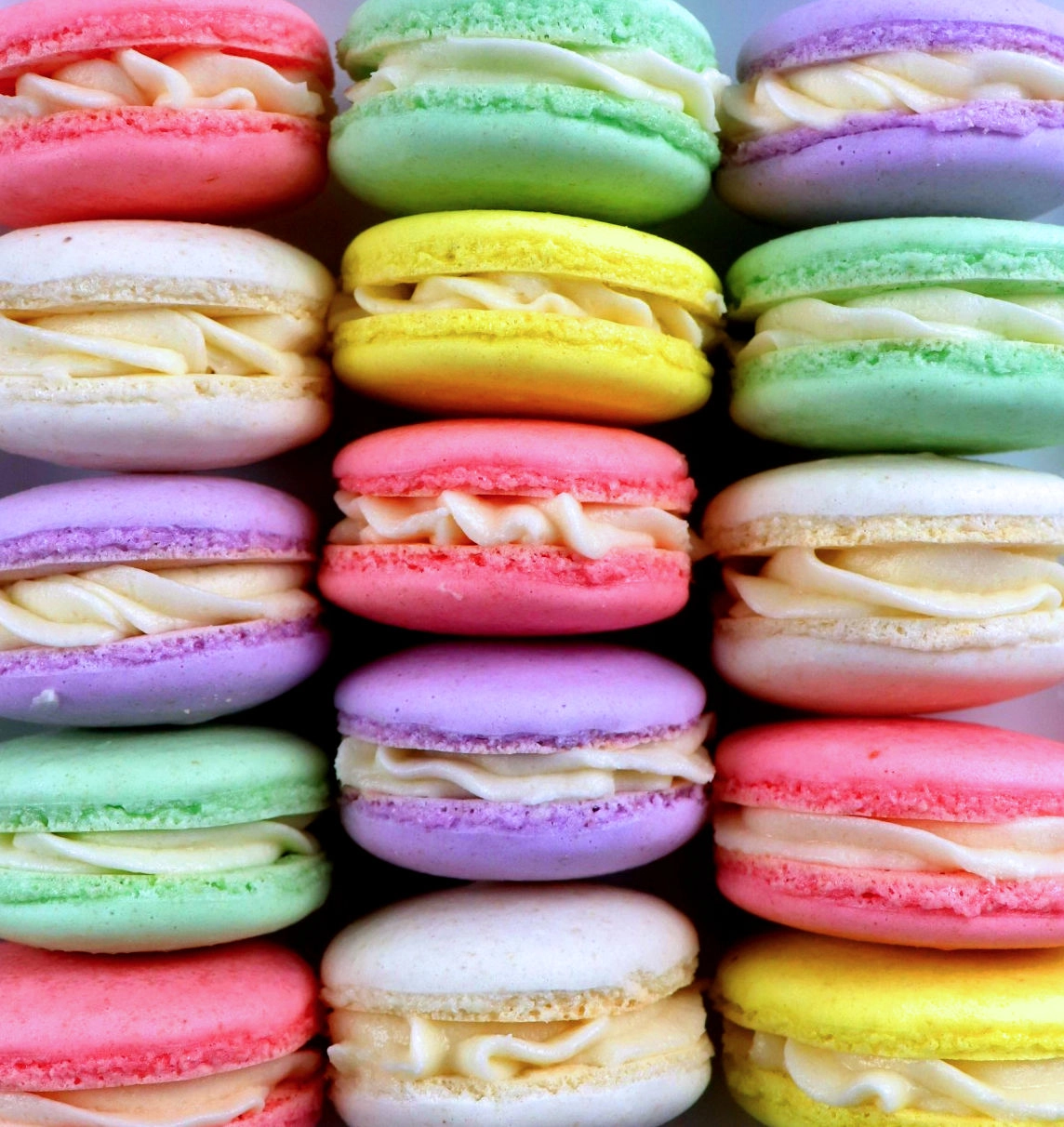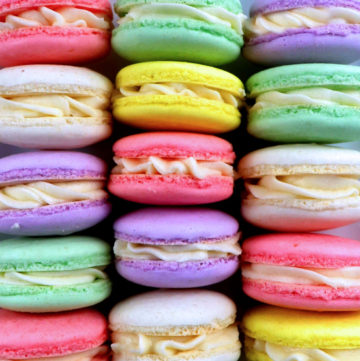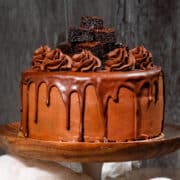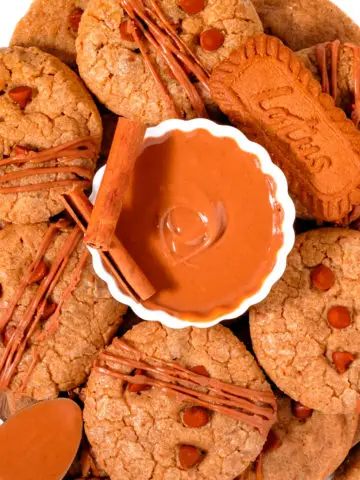This post includes everything you need to know, along with plenty of step-by-step pictures to help you learn how to make French macarons that come out perfect every time!
 French macarons are incredibly soft, light, chewy little sandwich cookies that taste absolutely amazing! They are fun and quick to make with just a handful of ingredients.
French macarons are incredibly soft, light, chewy little sandwich cookies that taste absolutely amazing! They are fun and quick to make with just a handful of ingredients.
Despite their deceptively simple appearance, macarons are actually quite technical and notoriously difficult to get right. They require a lot of precision and attention to detail, and there are a few crucial rules that need to be followed when making them. Don't let that intimidate you, though! With a little practice, you'll have them mastered in no time! And even if they don't turn out looking exactly perfect every time, they always taste delicious!
What are Macarons?
Not to be confused with French macaroons, which are coconut cookies, French macarons (mac-uh-rowns) are very soft, delicate cookies that are made with almond flour, powdered sugar, and an egg white meringue-base. The cookies are piped onto baking sheets, set out to dry, then quickly baked, and sandwiched together between some kind of filling.
A technically perfect macaron should be round, not hollow, and have a smooth, hard-shell surface with little ‘feet’ developed underneath.
What You Need to Make French Macarons:
Almond flour: Almond flour is made from blanched almonds that have been ground into a very fine powder. To get rid of any hard clumps it's important to sift the almond flour several times through a sieve before weighing it.
Sugar: Macarons are made with both granulated and powdered sugar. Powdered sugar is combined with almond flour to make up the dry ingredients in the batter. Granulated sugar is added to the egg whites to make the meringue and is what gives the meringue structure.
Egg whites: Egg whites are the main ingredient in the meringue. Separate the eggs while they're cold and then let the whites come to room temperature. Eggs are easier to separate while they're cold and egg whites are easier to whip into stiff peaks when they're at room temperature. Make sure there is absolutely no trace of yolk in the bowl with the egg whites or they won't whip to stiff peaks. If you do accidentally get a little yolk in the bowl it's best to just start over.
For 110g egg whites, you'll need 3-4 large eggs. Be sure to use a scale, because the weight of egg whites can vary by about 5g.
Cream of tartar: Adding cream of tartar to the egg whites helps stabilizes them and makes it easier to whip them to a higher volume.
Flavoring and food coloring (optional): Salt, vanilla extract (or another extract flavor), and a small amount of gel food coloring. Don't use liquid food coloring to dye the meringue because it will make the batter too runny. Also, be sure to add the coloring directly to the meringue before you add the dry ingredients.
Aged Egg Whites:
Aging the egg whites is optional and can result in a more stable meringue. The purpose is to dehydrate the egg whites, which makes them easier to whip to stiff peaks and also whip to a higher volume. If you plan ahead it's easy and doesn't hurt to do it. Just separate the eggs and place the whites in a small bowl, cover the bowl with plastic wrap, poke a few small holes on top, and keep them in the fridge for 1-3 days before using. Don't worry if you skip this step, though, I've made macarons with fresh egg whites plenty of times and I honestly haven't noticed a difference between using aged egg whites vs. fresh. Either way, be sure to let the egg whites come to room temperature for 1-3 hours before using them.
Tools Needed:
Kitchen scale: For the best results you're going to need a kitchen scale, there's just too much room for error otherwise. This is the one I have, it's waterproof and also rechargeable which I love.
Food processor: For pulsing the granulated sugar into a finer texture. You can skip this step if you're using baker's sugar, which is ultra-fine sugar and is sold in the baking aisle at most grocery stores.
Macaron template: Using a template is the best way to pipe even macarons. You can download a printable one, buy a silicone reusable template or make your own DIY version by tracing 2" circles onto parchment paper. Just find something round with a 2" diameter that you can trace, I used a shot glass to make mine. For this recipe, you need two templates with 24 circles on each.
How to Make French Macarons:
Take the egg whites out of the fridge at least 1 hour ahead of time so they can come to room temperature.
Prepare two baking sheets: Place your macaron templates onto 2 - large rimmed baking sheets with another sheet of parchment paper on top. You can lightly spray the template with non-stick spray so the top parchment paper sticks to it.
Have several clean and dry glass bowls ready and also clean and dry your food processor, sieve, spatula, whisk/mixers, and any other equipment you'll be using.
Use a sieve to sift the almond flour, powdered sugar, and granulated sugar, separately, and keep them in separate bowls.
After sifting, place a clean glass bowl on your food scale, set the scale to '0' (in grams), and weigh each of the ingredients, separately, and in separate bowls. Mix the almond flour and powdered sugar in one bowl, and add the sugar to the bowl of a food processor. Pulse the sugar in the food processor for about 5 seconds until it's a very fine texture.
Make the Meringue:
Add the room temperature egg whites and cream of tartar to a large, clean, and dry glass bowl. Use a hand-held mixer to beat the egg whites to soft peaks. This will take about one minute, the egg whites will be foamy at first and then start to thicken.
Add the granulated sugar and continue to beat until the meringue reaches stiff, glossy peaks. About 2-4 minutes. You should be able to hold the bowl upside down without the meringue budging at all. Add the salt, vanilla extract (or another flavor extract, if using), and gel food coloring (if using), and mix until combined.
 Macaronage:
Macaronage:
Macaronage is a fancy word for folding the dry ingredients into the meringue to make a macaron batter.
It can be tricky to get right because the meringue needs to be properly deflated just slightly during folding for the batter to be the right consistency. If it's under-deflated, you'll end up with hollow, puffed-up macaron shells, and if it's over-deflated, the batter will be too runny.
Add the dry ingredients to the meringue in 3 additions and use a rubber spatula to fold in each until the batter is smooth and glossy with no pockets of flour remaining.
 After the last addition, fold just until the batter reaches the right consistency. It should be smooth, glossy, not too runny, and flow in thick ribbons from your spatula.
After the last addition, fold just until the batter reaches the right consistency. It should be smooth, glossy, not too runny, and flow in thick ribbons from your spatula.
 Pipe the Macaron Batter:
Pipe the Macaron Batter:
Add the macaron batter to a piping bag with a round piping tip or with the tip of the bag cut off.
Hold the bag vertical to the parchment paper with the tip right in the center of the circle on the template. Gently squeeze the bag until the batter spreads out and mostly fills the circle.
 Once you've piped all of the circles, lift the pan about 5" and drop it onto your counter several times to release any trapped air bubbles in the batter. The batter will spread slightly and you should see tiny bubbles of air rise to the surface and pop.
Once you've piped all of the circles, lift the pan about 5" and drop it onto your counter several times to release any trapped air bubbles in the batter. The batter will spread slightly and you should see tiny bubbles of air rise to the surface and pop.
 Dry the Shells:
Dry the Shells:
Before baking, you need to let the macaron shells dry out for 45 minutes - 1 hour. As they dry, they'll start to form a hard surface, you should be able to touch the tops without wet batter sticking to your finger. If they aren't dried long enough the tops of the shells will crack in the oven.
Bake the Macarons:
Preheat your oven to 300°F and bake the macarons, one baking sheet at a time, for 10 minutes each. As the macarons bake they will form a smooth, hard surface with little feet developed underneath.
 Remove from the oven and allow the macarons to cool completely, they will be very delicate when you first take them out so don't try to touch them too soon.
Remove from the oven and allow the macarons to cool completely, they will be very delicate when you first take them out so don't try to touch them too soon.
You can place the entire baking sheet in the freezer for about 10 minutes, which makes it much easier to take them off of the parchment paper without breaking.
 Filling the Shells:
Filling the Shells:
To fill the shells I used vanilla buttercream frosting, but feel free to fill them however you'd like. I have a few filling suggestions listed below.
Pipe the filling onto the bottom of one shell, then take a second shell that's close to the same size and gently sandwich the two together.
 More Ways to Fill French Macarons:
More Ways to Fill French Macarons:
- Lemon Curd: Perfect for using the leftover egg yolks!
- Homemade Caramel Sauce
- Cream Cheese Frosting: Cut the frosting recipe in half to make enough to fill 24 cookies.
- Chocolate Ganache: Easy to make with just two ingredients: chocolate and cream.
- Pastry Cream: AKA creme patissiere, which is a thick custard made with eggs, milk, and sugar.
- Peanut Butter: Or any nut butter.
- Ice Cream: Macaron ice cream sandwiches? Yes, please!
- Whipped Cream: You can also add a little softened cream cheese to make stabilized whipped cream that holds its shape.
- French Buttercream: French buttercream is a frosting made with egg yolks and kind of resembles a custard.
- Italian Meringue Buttercream: A very soft and light frosting that’s not overly sweet.
- Swiss Meringue Buttercream: Soft and light, similar to Italian buttercream but easier to make.
 To make these multi-colored macarons, I made multiple batches and dyed the meringue a different color for each. The white one in the picture above is what the macarons look like without any coloring added.
To make these multi-colored macarons, I made multiple batches and dyed the meringue a different color for each. The white one in the picture above is what the macarons look like without any coloring added.
Store the filled macarons in the fridge and enjoy within 2-4 days. Macaron shells stay fresh, unfilled, for up to 1 week in the fridge.
Enjoy and please let me know if you make these!
📖 RECIPE

French Macarons
Equipment
- Food processor
- Sieve
Ingredients
- 100 g almond flour
- 110 g powdered sugar
- 110 g egg whites
- ¼ teaspoon cream of tartar
- 130 g granulated sugar
- ¼ teaspoon salt
- ½ teaspoon vanilla (or another flavor) extract, optional
- gel food coloring, optional
Vanilla Buttercream:
- 6 tablespoon unsalted butter, softened to room temperature
- 1 and ½ cups powdered sugar
- 1 and ½ tablespoon heavy cream
- ¾ teaspoon vanilla extract
- ⅛ teaspoon salt
Instructions
- Weigh the egg whites in a small bowl and leave them out at room temperature for at least 1 hour to come to room temperature.
- Prepare two baking sheets: Place your macaron templates onto 2 - large rimmed baking sheets with another sheet of parchment paper on top. You can lightly spray the template with non-stick spray so the top parchment paper sticks to it.
- Have several clean and dry glass bowls ready and also clean and dry your food processor, sieve, spatula, whisk/mixers, and any other equipment you'll be using.
- Use a sieve to sift the almond flour, powdered sugar, and granulated sugar, separately, and keep them in separate bowls.
- After sifting, place a clean glass bowl on your food scale, set the scale to '0' (in grams), and weigh each of the ingredients, separately, and in separate bowls. Mix the almond flour and powdered sugar in one bowl, and add the sugar to the bowl of a food processor. Pulse the sugar in the food processor for about 5 seconds until it's a very fine texture.
Make the Meringue:
- Add the room temperature egg whites and cream of tartar to a large, clean, and dry glass bowl. Use a hand-held mixer to beat the egg whites to soft peaks. This will take about one minute, the egg whites will be foamy at first and then start to thicken.
- Add the granulated sugar and continue to beat until the meringue reaches stiff, glossy peaks. About 2-4 minutes. You should be able to hold the bowl upside down without the meringue budging at all. Add the salt, vanilla extract (or another flavor extract, if using), and gel food coloring (if using), and mix until combined.
Macaronage: (Folding the macaron batter)
- Add the dry ingredients to the meringue in 3 additions and use a rubber spatula to fold in each until the batter is smooth and glossy with no pockets of flour remaining.
- After the last addition, fold just until the batter reaches the right consistency. It should be smooth, glossy, not too runny, and flow in thick ribbons from your spatula.
Pipe the Macaron Batter:
- Add the macaron batter to a piping bag with a round piping tip or with the tip of the bag cut off.
- Hold the bag vertical to the parchment paper with the tip right in the center of the circle on the template. Gently squeeze the bag until the batter spreads out and mostly fills the circle.
- Once you've piped all of the circles, lift the pan about 5" and drop it onto your counter several times to release any trapped air bubbles in the batter. The batter will spread slightly and you should see tiny bubbles of air rise to the surface and pop.
Dry the Shells:
- Before baking, you need to let the macaron shells dry out for 45 minutes - 1 hour. As they dry, they'll start to form a hard surface, you should be able to touch the tops without wet batter sticking to your finger. If they aren't dried long enough the tops of the shells will crack in the oven.
Bake the Macarons:
- Preheat your oven to 300°F and bake the macarons, one baking sheet at a time, for 10 minutes each. As the macarons bake they will form a smooth, hard surface with little feet developed underneath.
- Remove from the oven and allow the macarons to cool completely, they will be very delicate when you first take them out so don't try to touch them too soon.
- Let the macarons cool completely before removing from the sheet. You can place the entire baking sheet in the freezer for about 10 minutes, which makes it much easier to take them off of the parchment paper without breaking.
Vanilla Buttercream Filling:
- In a medium bowl, use a hand-held mixer to beat the softened butter, powdered sugar, heavy cream, vanilla extract, and salt until smooth.
- Pipe or spread the filling onto the bottom of one shell, then take a second shell that's close to the same size and gently sandwich the two together.
Notes
- 100g almond flour : 1 and ⅓ cups (measure after sifting)
- 110g powdered sugar: 1 and ⅓ cups (measure after sifting)
- 110g egg whites: slightly under ½ cup egg whites from 3-4 large eggs
- 130g granulated sugar: ⅔ cup (measure after sifting and before pulsing in the food processor)


















Leave a Reply